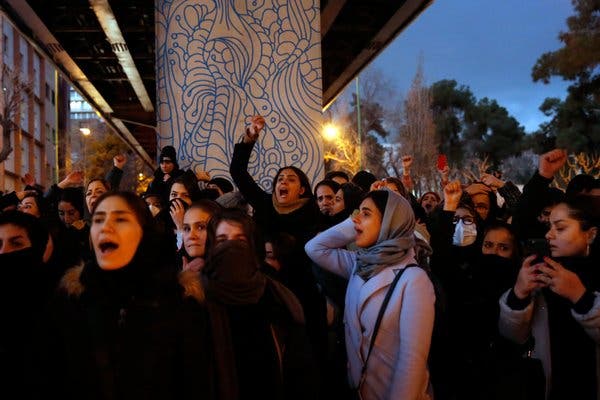US and Iran: A History, Timeline, and What You Need To Know

Protestors outside of a university in Iran after the downing of a Ukrainian passenger jet.
As high school students, it is crucial for us to stay informed. The ongoing events circulating the current tensions between the United States and Iran draws attention to why there is conflict in the first place and the importance of current events. Junior Makoa Inciong said, “The more informed you are about the world around you, the better you can make decisions for the good of society. Most kids get their news from social media instead of actual sources like news and media companies, but that’s [reliability] debatable.”So, here’s a brief history lesson, to clear the air on all of this “WW3” business plastered through our Instagram feeds.
In 1953, US and British intelligence organized a coup to eradicate Iran’s democratically elected Prime Minister Mohammad Mossadegh to ensure western control of Iran’s oil resources and block the Soviet Union’s influence over Iranian oil.
In 1979, the US-backed Sha of Iran, Mohammed Reza Pahlevi, who emphasized pro-western foreign policy and capitalistic ideals, was forced out of the country after months of protests and strikes against his rule and the Monarchy’s disregard for Iran’s constitution and religious ideals with religious leader Ayatollah Khomeini at the face of the rebellion. Within two weeks of the occurrence, The Islamic Republic of Iran, its new power, is proclaimed.
The US embassy in Tehran was occupied by protestors in November 1979. 52 Americans are taken hostage inside for 444 days. In 1981, the hostages were freed as President Ronald Reagan was inaugurated into office.
With his State of the Union address in 2002, President George Bush denounces Iran as a part of an “axis of evil” with Iraq and North Korea. This causes outrage and discourse in Iran.
In the early 2000s, Nuclear fears arise when the US accused Iran of a “clandestine nuclear weapons program. Iran denies the accusations, yet several rounds of sanctions are imposed on Iran by the UN, US, and the EU against Mahmoud Ahmadinejad’s government, crippling Iran’s economy and causing Iran’s economy to lose two-thirds of its value in two years.
In 2015, The Iran Nuclear Deal was established. The deal is made between Iran and the US, UK, France, China, Russia, and Germany. Iran agrees to put a limit on its nuclear activities, along with allowing international inspectors within its facilities. In return, the debilitating economic sanctions are lifted.
In May 2018, US President Donald Trump left the nuclear deal and reestablished the economic sanctions against Iran. Trump then threatens to enforce the same sanctions on other countries if they continue to buy Iranian oil. As a result, Iran falls into a deep economic depression. Relations between the US and Iran worsen.
In July 2019, Iran rolled back key pledges under the nuclear deal.
With the start of 2020, General Qasem Soleimani, Iran’s highest military commander, is assassinated in Iraq by a US drone strike on January 3rd. In response, Iran vows severe revenge on America and withdraws from the 2015 nuclear deal.
Tensions remain high between the US and Iran.

EMAIL: [email protected]
I joined the Ka Moi team to learn about the journalism world and to be apart of a group of young Hawaiians with a powerful voice. I want to travel around the world after attending college and join the Peace Corps. I am passionate about solving social and environmental issues. I surf as much as I can and I enjoy running distance races for track and cross country. I wants to be able to look back on my life when I am older with no regrets or bitterness.


Preston Ponteras • Feb 12, 2020 at 9:23 am
I really think it’s important for students especially in Hawaii to be informed about all of the current events around the world. Keep up the good work Mahea and the rest of the Ka Moi staff. You guys should do one on the Coronavirus next!